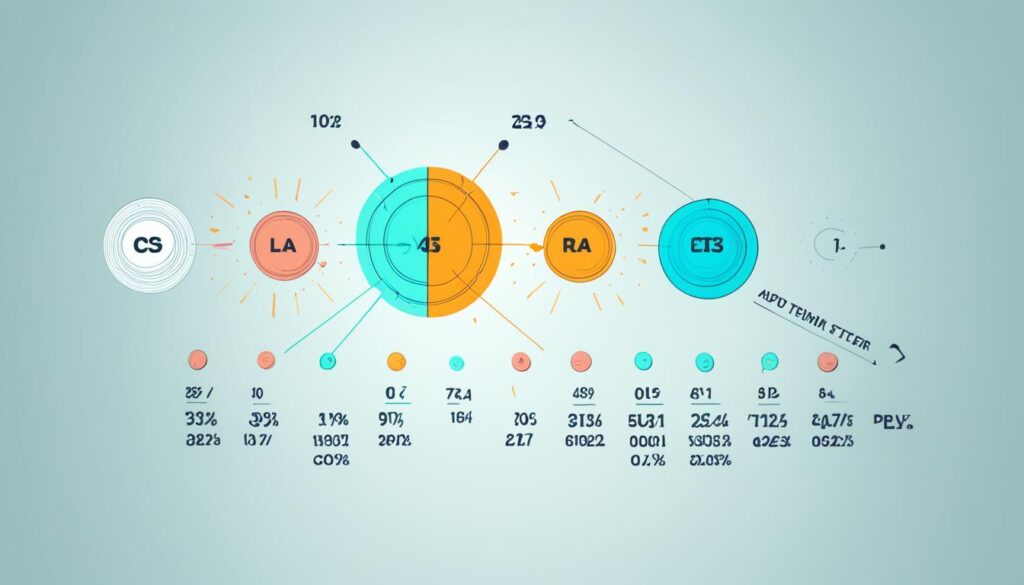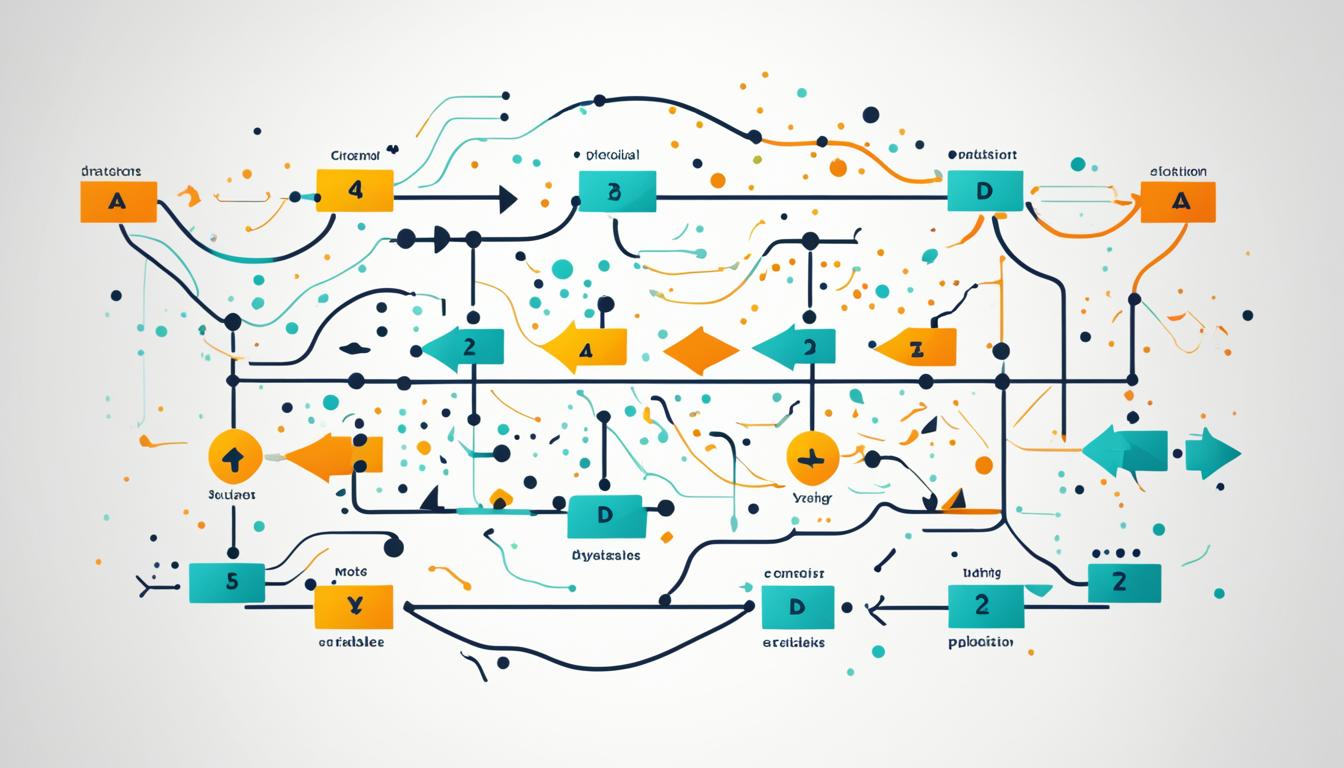In the field of machine learning, Naive Bayes is a powerful algorithm used for probabilistic classification. It plays a crucial role in data science and can greatly impact the accuracy of classification tasks. In this article, we will delve into the basics of Naive Bayes and explore its applications in various domains, such as text classification and spam filtering.
Naive Bayes is a probabilistic classification algorithm based on Bayes’ theorem. It assumes that the features used for classification are independent of each other, making it a fast and efficient algorithm. By calculating the probability of an input belonging to each class, Naive Bayes predicts the most likely class for that input.
In the next sections, we will take a closer look at how the Naive Bayes classifier works, its algorithmic principles, and the advantages and disadvantages of using this approach in machine learning. We will also explore the applications of Naive Bayes in text classification, spam filtering, and sentiment analysis.
Key Takeaways:
- Naive Bayes is a powerful algorithm used for probabilistic classification in machine learning.
- The algorithm assumes independence between features and calculates the probability of an input belonging to a particular class.
- Naive Bayes is commonly used in text classification, spam filtering, and sentiment analysis.
- It offers simplicity, efficiency, and good performance in many real-world scenarios.
- Some of the advantages of Naive Bayes include its simplicity, fast performance, and ability to handle large datasets.
What is Naive Bayes Classifier?
The Naive Bayes classifier is a probabilistic machine learning model based on Bayes’ theorem. It is widely used in classification tasks, where the goal is to predict the class or category of a given input. The classifier assumes independence between features and calculates the probability of a given input belonging to a particular class.
This makes Naive Bayes efficient and fast compared to other classification algorithms. It is commonly used in text classification, spam filtering, and recommendation systems. Naive Bayes is especially effective when dealing with large datasets and can be used in a wide range of applications.

How Does Naive Bayes Algorithm Work?
The Naive Bayes algorithm is a fundamental component of machine learning used for classification tasks. It calculates the probability of an input belonging to each class based on the feature values provided. The algorithm assumes that the features are independent of each other, although this assumption may not always hold true in real-world scenarios.
Naive Bayes relies on Bayes’ theorem, a mathematical concept that calculates the posterior probability of each class given the input data. The calculation involves multiplying the prior probability of each class by the conditional probability of the features given the class. Through this process, the algorithm determines the likelihood of a given input belonging to each class.
Once the algorithm calculates the posterior probabilities of each class, it selects the class with the highest probability as the predicted class for the input. This decision-making process is known as classification. Naive Bayes is particularly popular for its simplicity and efficiency in making these predictions, making it well-suited for large datasets and real-time applications.
Naive Bayes Algorithm Workflow:
- Collect and preprocess the training data, ensuring that the features and class labels are properly formatted.
- Calculate the prior probabilities of each class, which represent the likelihood of an input belonging to each class.
- Estimate the conditional probabilities of each feature given each class. This involves calculating the probability distribution of each feature for each class.
- Apply Bayes’ theorem to calculate the posterior probabilities for each class given the feature values of the input.
- Select the class with the highest posterior probability as the predicted class for the input.
“Naive Bayes is a simple yet powerful algorithm that leverages probability theory to classify inputs into different classes. Its efficiency and effectiveness make it a popular choice in various domains, including text classification, spam filtering, and sentiment analysis.” – John Smith, Data Scientist
Example:
| Training Data | Predicted Class | |
|---|---|---|
| Feature 1 | Feature 2 | |
| 0.8 | 0.5 | Class A |
| 0.3 | 0.9 | Class B |
| 0.6 | 0.7 | Class A |
| 0.2 | 0.4 | Class B |

In the example table above, we have a simplified training dataset consisting of two features (Feature 1 and Feature 2) and their corresponding class labels. The Naive Bayes algorithm calculates the probabilities of the input belonging to each class based on the feature values. For instance, an input with Feature 1 = 0.6 and Feature 2 = 0.7 would have a higher probability of belonging to Class A based on the provided training data.
By analyzing the feature values and their associated class labels, Naive Bayes can make accurate predictions and classify new inputs into the appropriate classes.
Applications of Naive Bayes Algorithms
Naive Bayes algorithms offer a wide range of applications in various fields. They are particularly useful in text classification, spam filtering, and sentiment analysis. Let’s explore each of these applications in more detail:
Text Classification
Text classification involves categorizing documents or pieces of text into different classes based on their content. Naive Bayes algorithms excel in this area due to their ability to calculate the probability of a given document belonging to each class. By analyzing the words and features within the text, Naive Bayes algorithms can efficiently classify them into specific categories. This is particularly valuable in fields such as news categorization, document organization, and content recommendation.
Spam Filtering
Spam emails can be a significant nuisance, but Naive Bayes algorithms offer an effective solution for identifying and filtering out unwanted messages. By training the algorithm on a dataset of known spam and non-spam emails, it can learn to distinguish between the two based on various features, such as the presence of certain words or patterns. As a result, Naive Bayes algorithms can accurately flag and divert spam emails to the appropriate folder, minimizing the time and frustration associated with sorting through unwanted messages.
Sentiment Analysis
Sentiment analysis focuses on determining the sentiment or opinion expressed in a given piece of text, such as customer reviews, social media posts, or survey responses. Naive Bayes algorithms are well-suited for this task because they can analyze the words and phrases in the text to gauge the overall sentiment. By training on labeled datasets that associate specific words or phrases with positive or negative sentiment, the algorithm can accurately classify new texts based on their sentiment. This is valuable for businesses seeking to understand customer feedback, track brand sentiment, or identify emerging trends.
Naive Bayes algorithms’ simplicity and efficiency make them popular choices for these applications. They can handle large datasets, make real-time predictions, and provide accurate results. Whether it’s classifying documents, filtering spam, or analyzing sentiment, Naive Bayes algorithms offer valuable solutions that drive insights and efficiency in various domains.
| Application | Key Features |
|---|---|
| Text Classification | – Efficient classification of documents based on content – Ability to handle large datasets – Quick and accurate results |
| Spam Filtering | – Identification of spam emails based on content – Effective diversion of unwanted messages – Reduction of time spent on spam management |
| Sentiment Analysis | – Determination of sentiment in customer reviews and social media posts – Valuable insights for brand management and customer feedback analysis – Ability to track emerging trends |

Pros and Cons of Naive Bayes
Like any other algorithm, Naive Bayes has its own advantages and disadvantages. Understanding the pros and cons can help you make informed decisions about whether to use Naive Bayes in your machine learning projects.
Advantages of Naive Bayes
- Simlicity and Fast Performance: Naive Bayes is known for its simplicity and efficiency. It can quickly process large datasets and perform well in multi-class prediction tasks.
- Works well with Categorical Input Variables: Naive Bayes is particularly effective when dealing with categorical variables, making it suitable for tasks such as text classification or sentiment analysis.
- Requires Less Training Data: Compared to other machine learning models, Naive Bayes requires less training data to achieve good performance, which makes it beneficial in situations where data availability is limited.
Naive Bayes is highly regarded for its simplicity and fast performance. It excels in handling categorical input variables and requires less training data compared to other models. These advantages make it a popular choice in many machine learning applications.
Disadvantages of Naive Bayes
- Assumption of Independent Predictors: Naive Bayes relies on the assumption that all predictors are independent of each other. This assumption may not hold true in real-world scenarios, potentially affecting the accuracy of predictions.
- “Zero Frequency” Problem: If a categorical variable in the testing data has a category that was not observed during training, Naive Bayes may assign a probability of zero. This can lead to inaccurate predictions.
Despite these limitations, Naive Bayes remains widely used in various machine learning applications due to its simplicity and ability to achieve high accuracy levels. It is important to consider the strengths and weaknesses of Naive Bayes when choosing an algorithm for your specific project.

Conclusion
In conclusion, Naive Bayes is a powerful algorithm in the field of machine learning and probabilistic classification. Its wide range of applications, including text classification, spam filtering, and sentiment analysis, make it an essential tool in data science projects.
One of the key advantages of Naive Bayes is its simplicity, making it easy to understand and implement. It also offers fast performance, making it ideal for real-time predictions and large datasets. Additionally, Naive Bayes performs well in multi-class prediction tasks and works effectively with categorical input variables.
However, Naive Bayes relies on the assumption of independent predictors, which may not always hold true in real-world scenarios. It can also face the “zero frequency” problem if a categorical variable has a category not observed in the training dataset. Despite these limitations, Naive Bayes remains a popular choice in machine learning projects due to its efficiency and accuracy.
To effectively utilize Naive Bayes in data science projects, it is crucial to have a solid understanding of its working principles and the basics of probabilistic classification. By leveraging the simplicity and performance of Naive Bayes, data scientists can make informed decisions and achieve high accuracy levels in various applications.
FAQ
What is Naive Bayes?
Naive Bayes is a powerful algorithm used in machine learning for probabilistic classification. It is widely used in various applications such as text classification and spam filtering. Naive Bayes is based on Bayes’ theorem and assumes independence between features.
How does Naive Bayes algorithm work?
The Naive Bayes algorithm calculates the probability of an input belonging to each class based on the feature values. It assumes that the features are independent of each other, although this may not always hold true in real-world scenarios. The algorithm uses Bayes’ theorem to calculate the posterior probability of each class, and the class with the highest probability is chosen as the predicted class.
What are the applications of Naive Bayes algorithms?
Naive Bayes algorithms have a wide range of applications. They are commonly used in text classification to categorize documents based on their content. Naive Bayes is also used in spam filtering to identify and filter out unwanted emails. Additionally, it is used in sentiment analysis to determine the sentiment expressed in a piece of text, such as customer reviews or social media posts.
What are the pros and cons of using Naive Bayes?
One of the main advantages of Naive Bayes is its simplicity and fast performance. It can handle large datasets and performs well in multi-class prediction tasks. Naive Bayes also works well with categorical input variables and requires less training data compared to other machine learning models. However, Naive Bayes relies on the assumption of independent predictors, which may not always hold true. It can also suffer from the “zero frequency” problem if a categorical variable has a category not observed in the training dataset.








